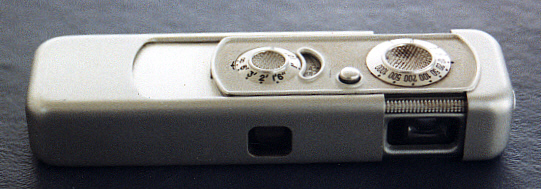

A Minox Spy Camera
While searching the contents of Lee Oswald's sea bag on the day after the assassination, Detectives Gus Rose and Richard Stovall discovered a Minox camera. Opening the camera, Rose discovered a roll of film inside it and recorded it in his inventory of items taken from the Paine house:

On November 26, 1963, two days after Oswald's death, Dallas police turned over the evidence to the FBI who took charge of the investigation. Every piece of evidence was cataloged, and signed for by FBI Agent Warren DeBrueys.

However, the FBI contacted Rose and Stovall and informed them that there was no camera, just a Minox light meter. They pressured the detectives to change their inventory. According to Rose's HSCA deposition:
We found this camera and of course, we brought it and a whole lot of other property in, as possible evidence in the case. And uh, while we were marking the evidence for later identification by us to be used in evidence we did, Stowall and I, did take a close look at this Minnox minature camera and it did have a roll of film in it. As time passed and after the Warren Commission was appointed, uh, a couple of F.B.I. agents made three different trips to our office to talk to me about this camera. They said that after they had received all the property they found that I had made a mistake, and that that really wasn't a camera, it was a Minnox light meter. However, as I told them at the time, I was sure that I had not made a mistake, it definitely was a camera and definitely did have film in it. However, they wanted me to change that in our property invoice to read Minnox light meter and not read Minnox camera. We never did change it. Uh, Captain Fritz instructed me if I was sure I was right not to make any changes in any reports, to stay with what was right.
Several weeks after the assassination, the FBI also contacted Dallas Police property manager H. W. Hill, who complied with their request and made the notation on the property invoice. It is that altered copy that appears in the Warren Commission exhibits.
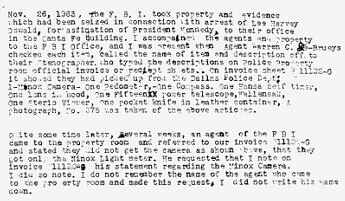

Dallas Assistant District Attorney William Alexander also confirms the existence of the Minox camera found in Oswald's sea bag:
The FBI denied the existence of a very small pocket Minox camera found among Oswald's belongings. We picked up a Minox camera which had some film in it and turned it over to the FBI. Despite their denials, claiming it was a light meter, I examined it, and I know a camera when I see one. We had the Minox camera and that was all there was to it! In those days, a Minox camera probably cost around $200. What inference can be drawn from it? Who knows, unless he was an intelligence buff and had bought it through a PX. Obviously, it leads to speculation about his being involved in some kind of intelligence.
(Larry Sneed's No More Silence pg. 551)
Finally, here is a page from a Dallas Police log book showing that they turned over a Minox camera to the FBI:
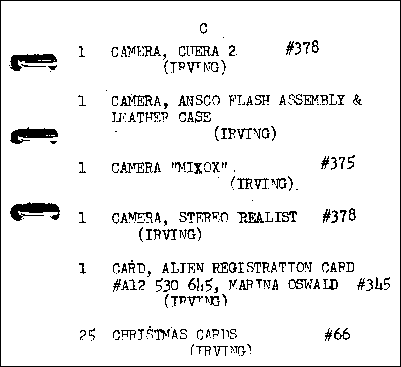
On the day before the FBI officially took possession of the evidence, the FBI requested a comparison of the Minox film recovered from the possessions of Lee Harvey Oswald with another roll of Minox film, designated Q5.
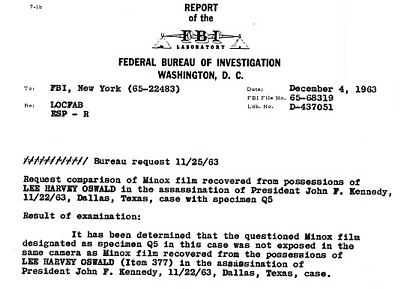
Item 377 on Property report G-11193 dated November 26, 1963 shows "two rolls apparently exposed Minox film":

These two rolls of Minox film (#377) appear to belong to the Paines, and are photographs of their European vacation. The FBI did not take possession of these films until 11/26/63. Therefore, the film recovered from Oswald's possessions on or before November 25th must be the roll of film recovered from the Minox camera found in Oswald's sea bag.
The Minox film belonging to the Paines was found in Minox containers that held two rolls of film. In the DPD evidence photo, a loose roll of Minox film can be seen by the case and name tags. The FBI returned the Minox case and name tags to Ruth Paine, but inexplicably, they were not part of the November 26th transfer. I believe the FBI had taken possession of these items (case, name tags, roll of film as well as the light meter that was substituted for the Minox camera) before the 25th of November. It is my opinion that this roll of film that came from Oswald's camera, and was the film the FBI lab compared to sample Q-5.
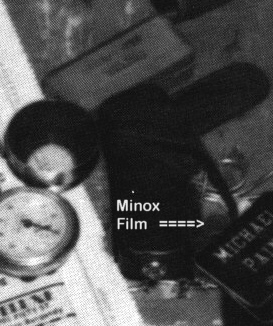
On January 30, 1964, J. Edgar Hoover sent a memorandum to the Dallas SAC ordering an investigation into the matter of the missing Minox. It was the official position of the bureau that no Minox was recovered from the Paine house, but yet there was film and accessories that indicated that such a camera existed.

That same day, Ruth Paine was contacted and informed the Dallas office that her husband did own a Minox camera, but that it was no longer working. According to a report dated January 31, 1964 by SA Bardwell Odum:
He {Paine} owns a Minox camera and that camera is at his home in Irving, Texas. Several years ago he dropped this camera in salt water off the coast of Cape Cod, Massachusetts, and after retrieving it, soaking it in kerosine and cleaning same, it appeared to be in good working condition. Thereafter, someone bent the shutter by pulling the lens out too far, and, to the best of his knowledge, it is not now in working condition. He stated that he did have some cans of film, and that some of them were probably exposed film, but that the pictures made on this film were at least five years old. He stated that he had a case for the camera and other accessories including a light meter. He stated that when the police came to his house on November 22, 1963, they took the entire contents on a drawer containing photographic equipment which included the items mentioned above with the exception of the camera. He stated that this camera was in his garage at that time and that although he mentioned the camera to the police, they did not seem interested in it. He stated that he is sure LEE HARVEY OSWALD never used this camera, and he is of the opinion that it is not in working condition at the present time. Mr. Paine stated he had no knowledge of a 'no admittance' sign which was picked-up by the police at his residence. He stated this sign is not his and he has never seen it before." FBI DL 100-10461
A Minox III camera, serial number 27259, was turned over to the FBI on January 31, 1964, and was given the designation D-80.
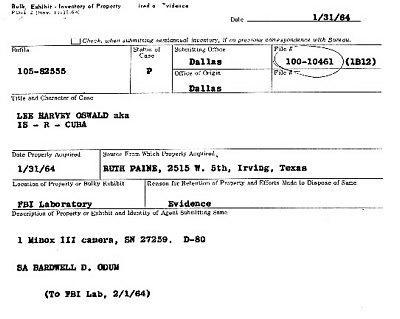
The inventory shows that the camera was acquired from Ruth Paine, as does CD 385 and CD 735. However, Ruth Paine later stated that she does not ever recall giving the camera to the FBI. Another FBI document, also dated January 31, 1964, shows that the camera was given to the FBI by Michael Paine.
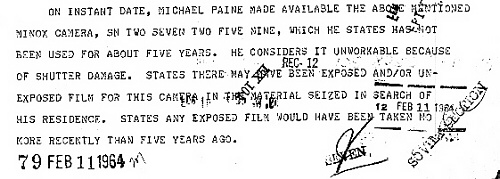
What happened to the Paine Minox??? According to Michael Paine, the camera was returned to him shortly after the assassination and was eventually stolen along with his other photographic equipment about five years later.
When Marina Oswald Porter appeared before the House Select Committee on Assassinations, she was shown two Minox cameras and asked if she had ever seen either one before. One of the cameras, a model III with no serial number, came from the National Archives. The other Minox, described as a model I, serial #S2339303:
Q. This exhibit here which is identified as FBI exhibit D-80, does this look familiar to you?
A. No.
Q. And this camera here which is a Minox 1 :3.5 F-15 millimeter with the serial No. S2339303, does this look familiar to you?
A. No.
Q. Did you ever see any of the cameras before you in the possession of Lee?
A. I do not recall now at all the camera we used to have. The camera could be here but I would not recognize it at all.
Q. You just don't remember?
A. No.
Q. If I show you this camera which was Commission exhibit No. 750 and raise the top part so you can see there is a viewfinder and ask you just to look at the camera, would that refresh your recollection that that was the camera you allegedly took the photographs of Lee with?
A. Well, I honestly do not remember if I look straight at the object or look down.
Q. But seeing the camera today you still have no memory of what the camera looked like?
A. No; I am sorry I am unprofessional about it.
Q. Whatever your memory is, that is what we want to find out. A. I definitely never saw that before.
Q. Which are you referring to?
A. These two little ones.
Q. The record should note that she is referring to the Minox camera which is D-80 and the other Minox camera which is identified on the record as Minox 1 :3.5.
A. And by that I mean in my possession or Lee's possession.
Q. You never saw a camera like that?
A. No.
After some unrelated testimony about Lee Oswald's photography, Mr. Wolf returns to the subject of the two Minox cameras:
Mr. WOLF. Back on the record.
We are going to take a lunch break. At the current time it is approximately 12:40.
I would also like to state on the record that regarding the cameras that Mrs. Porter examined previously, concerning the two Minox cameras, so there is no confusion on the record, the Minox which was not part of the material in the National Archives and which has serial No. 2339303 is approximately 1 1/2 inches longer than the one which is currently in the National Archives.
At this time we will take a break for lunch.
[Whereupon, at 12:39 p.m., a recess was taken until 2: 15 p.m.]
There are several things to note in this exchange. First of all, the Minox III was referred to as exhibit D-80, which was the designation given to Michael Paine's Minox. But supposedly, D-80 had been returned to Paine, and by this time had been stolen. Could it be that the Oswald Minox became D-80 once the Paine Minox had been released from evidence??? Or was the wrong camera released to Michael Paine??? One thing's for certain, there is a Minox III in the Archives today.
But what of the other Minox displayed to Marina??? A model I would be the same size as a model III, not 1 1/2 inches longer. The only Minox to match that description would be a Model C, which was produced between 1969 and 1978.

A check of the serial number 2339303 proves that the camera is indeed a Minox C, a camera first manufactured six years after the assassination, and the current production model at the time of the HSCA. (Serial numbers for the model C range between 2300101 and 2473694). Why would the House Select Committee ask Marina to identify a camera that couldn't have possibly belonged to her husband???

In February 1999, I had the pleasure of discussing this matter by telephone with John Armstrong. I asked John if he could determine what model Minox was in the Archives, and after consulting one of his photographs of the Archives camera, he informed me that it was in fact a model III. The camera was housed in a ammo box, and was identified as DL-3, and not D-80. He then told me that when he handled the camera, it was far heavier than a Minox should be. When he tried to look inside the camera to check its serial number, he found that it had been filled with some substance that prohibited its being fully opened. Perhaps this explains why Mr. Wolf did not state the serial number of the Minox III when he showed it to Marina.
Since the serial number is located inside the Minox where the film is loaded (see photo below), the FBI had to open the camera to determine the Paine's Minox was #27259. And we know that Detective Rose opened the Minox he discovered in Oswald's sea bag and found a roll of film inside. That seems to indicate that the camera in the Archives has been sealed shut after it had been taken into evidence.

However, a check of Minox serial numbers shows that camera #27259 should be a Model II Minox, not the Model III that the FBI claimed they received from the Paine's. (Model II serial numbers ranged from 20379 to 31500 while Model III serial numbers started with 31275 and ended with 58499).The Model II, first manufactured in 1948, was never officially imported or sold in the United States.
Bardwell Odum's 1/31/64 report states that Paine's Minox was not working at that time because "...someone bent the shutter by pulling the lens out too far, and, to the best of his knowledge, it is not now in working condition." What is interesting about this description of the damage is that the lens can not be "pulled out" since it is contained within the camera, but the rear element of the lens does move back and forth inside the film chamber as the film is advanced and the shutter is cocked.
Technical note: the rear element of the lens actually presses up against the film as the photo is taken. When you advance the film by pulling the camera apart, the lens moves away from the film to allow it to move freely. One of the differences between a Minox II and a Minox III is the lens itself. The model II had a five element lens which sometimes caused scratches on the film because it extended a fraction too deep into the film chamber. Minox replaced the lens on the model III with a four element design which did not extend quite as far into the film chamber, allowing the film to advance freely without scratches.
Could this actually be the problem Michael Paine described to the FBI??? If the lens jammed in the picture taking position, it could conceivably prevent the advance mechanism from operating. This would be consistent with the damaged camera presently in the Archives. If the camera in the Archives is the Paine camera, and that camera was jammed shut when Michael Paine turned it over to the FBI in 1964, then the serial number recorded on Odum's inventory is a fabrication. Keep in mind that the the number 27259 traces back to a model II, not a model III like the Paine camera. Could it be that #27259 was actually a model II found among Oswald's possessions by Detective Rose???
In 1978, researcher A. J. Weberman obtained copies of the Minox photos under an FOIA request. According to Weberman:
"The two rolls of Minox film that were taken with Michael Paine's Minox camera contained photos of a trip to Europe. The roll that was not taken with Michael Paine's camera seem to have been photographed in either Qemoy or Matsu. The photographs depicted several Marines horsing around on a large military vessel; a shot a tanker and LST-845P, shots of an island from offshore; shots entering a harbor; Asian children walking past a heavily fortified military base; a Chinese funeral passing the perimeter of the base, and a photo of OSWALD with an M-16."
In January 1999, I received photocopies of the Minox photos from the National Archives. Each sheet of paper had one photo on it, except for one page. The main photo on that page appears to be one of the offshore photos that Weberman described with a couple of Marines in the foreground. Included on that page are two additional photos showing a serviceman wearing the same kind of hat as one of the Marines in the main photo.

Immediately, it struck me that the serviceman bore a resemblance to Gerry Patrick Hemming. The notion that Oswald might have taken photos of Hemming with his Minox while still overseas bore serious implications. After posting the photos on the JFK Research Forum, I heard from a well-respected researcher who suggested that I contact Hemming, who had learned about the photos from Noel Twyman.
Shortly afterwards, I spoke to Hemming who acknowledged that he was familiar with Minox photos of him, but that they were not taken by Oswald. He informed me that Howard Davis had a Minox, and used it to take photos of their camps. It was Davis who took the photos in question.
Hemming told me that the Minox camera found in Oswald's sea bag originally came from Life reporter Richard Billings, who later authored the HSCA report and co-authored Robert Blakey's The Plot to Kill the President. Billings, who reported on the commando raids for Life magazine, gave the Minox to Hemming to photograph their various missions. Hemming in turn gave the camera to Eddie Bayo who disappeared with nine commandos while on a raid into Cuba. Hemming refused to speculate on how the Minox got from Bayo to Oswald.
Hemming did speculate that the military photos were not taken overseas, but more likely they were photos taken during one of their Cuba missions. Hemming did claim that Oswald did possess a Minox while he was stationed at El Toro, and that he used it to take photos at the Cuban Consulate in Monterey Park. Hemming said that he knows that Oswald did not take that camera to Russia, but he has no idea what happened to that camera.
If the FBI story that Oswald did not possess a Minox is true, then that means:
There are several disturbing issues that point to evidence manipulation:
Here are links to the various documents:
Go to the next page for more info about the disappearance of Oswald's Minox. Very important.
Click
Here to see an actual copy made by a Minox
Click Here for a
demonstration of the size of a Minox camera.
Return to Home Page